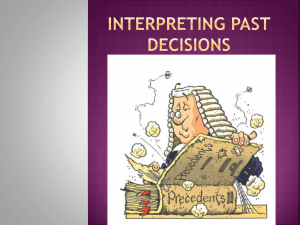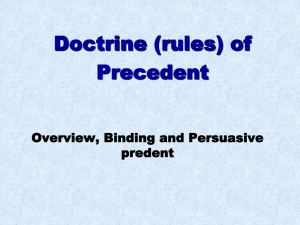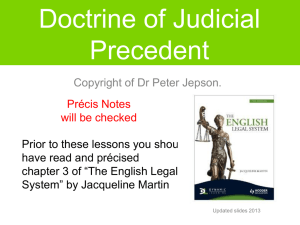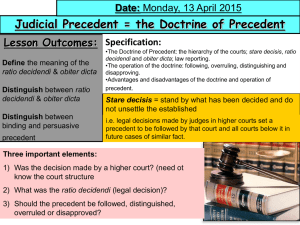Precedent Presentation
advertisement
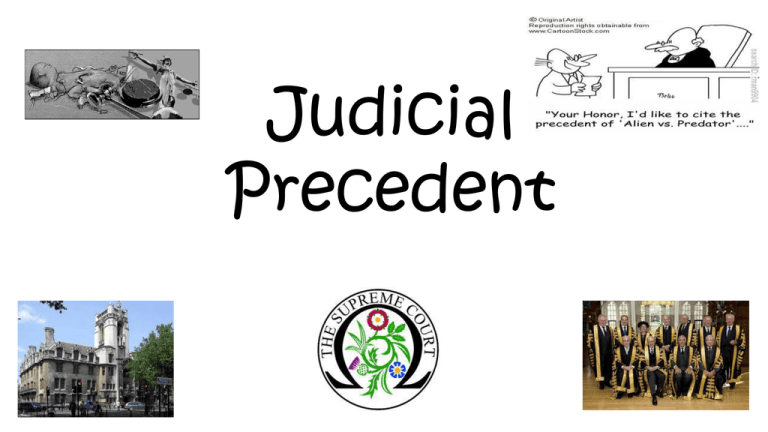
Judicial
Precedent
Hierarchy of the Courts:
How good are your powers of deduction?
Task:
On your table, you have a
number of cards, each of
which represents a court in
England and Wales.
Can you create the
hierarchy of the courts
using your knowledge?
You have five minutes
The
Answer:
Supreme
Court
Civil
Division
Generally, the lower
courts must follow the
decisions of the higher
courts, even if they
disagree with them.
There are provisions for
the higher courts to
change their own minds,
but the appellant has to
wait for his case to get
there.
Family
Division
Court of
Appeal
Divisional
Courts
Chancery
Division
Criminal
Division
Appelate
Courts
Queen’s
Bench
High
Court
County
Court
Crown
Court
Magistrates
Court
Lower
Courts
What about Europe?
As you know, we are members of the EU and have given legal
power to the European Convention on Human Rights. This
means that there are Courts which also have an influence on
our system.
European Communities Act 1972
Human Rights Act 1998
What about Europe?
As you know, we are members of the EU and have given legal
power to the European Convention on Human Rights. This
means that there are Courts which also have an influence on
our system.
European Court of Justice
European Communities Act 1972
European Court of Human Rights
Human Rights Act 1998
Why is precedent so important?
In England & Wales, we get our laws from two main places (there are others):
Appellate courts
have more that
one judge
hearing the case
Who?
We need precedent to keep judges under control,
and so that we know what the law is, and what we
can and can’t do.
What is precedent?
A judge must follow any decision by a higher
court in a case with similar material facts.
Courts should also follow their own previous
decisions.
This is known as ‘stare decisis’ or let the decision stand.
This means that courts should not change the law unless
they absolutely have to; certainty is more important than
injustice.
Precedent in Action
How it works
In the appellate courts,
judges have to explain not
just their decision but why
and how they came to that
conclusion.
This provides valuable
guidance to other judges,
when they are deciding
whether or not they are
bound.
IF a judge disagrees with the
majority, he also has to write
a report. But this is not
binding.
Judgements contain:
1. Facts of the case
2. The appeal grounds
3. Ratio decidendi
4. Orbiter Dicta
Ratio Decidendi
Means:
warning: there may be more than one ratio!
Case
Facts
Re A (Conjoined twins) 2000
Jodie and mary were conjoined
twins, and doctors sought a
declaration that they could
separate the twins, knowing that
Mary would die.
DD were involved in various
consensual sadomasochistic
activities and were charged with
various counts of ABH and GBH.
R v Brown 2005
Bonus Case:
Ratio:
Ratio
R v Bentham 2005
More Ratio…
Means:
Case
Obiter Dictum
Facts
Ratio
R v Howe
Duress is not a defence
to murder
Donoghue v Stevenson
A manufacturer owes a
duty of care to make
sure that the goods
don’t harm the client
Obiter
A typical exam question would be “Explain what
is meant by ratio decidendi and obiter dicta”
Applied
in…..
Gotts
Tutton v
AD
Walter
Student task
Can you apply the law correctly?
Precedent Setting Case:
A man is driving a 12 year old
Ford Escort in a residential
area at about 60mph and runs
over an old lady who was using a
zebra crossing
An old man is driving a 15 year
old Volvo in a residential area at
50 mph and hits a young boy
who is using a pelican crossing
A woman driving a brand new
Audi is doing 70mph, and hits a
hitchhiker
A woman is driving at 35mph in
a residential area, and comes
round a corner and hits an old
lady crossing the street
Courts in Practice:
A Case Study
R v Brown
House of Lords
Ratio:
R v Wilson
Court of Appeal
R v Emmett
Court of Appeal
What should the outcome
have been?
Which case should they
have followed?
What grounds did the court
distinguish on?
Which case did they follow
and why?
Do you agree?
How do judges know what an earlier court has said?
Law Reports
R v Shivpuri [1986] 2All ER 334
Year it
was
reported
The series
of reports
Page
number
How much have you learnt this lesson?
There are 10 mistakes in the paragraph below….can you find them all?
Precedent is one of the ways in which mp’s can make and interpret the law. It relies on a
strict court hierarchy, which creates ambiguity and consistency, preventing lower courts
from confusing the law.
It relies on the theory of obiter dictum, which says that a court should always follow the
previous decision, where possible, even if it leads to an injustice. To decide whether or not
the court is followed, the judge should look at the singular facts. If they are sufficiently
similar, the court is bound to follow the earlier decision.
Judges must write a report when handing down their decision. This explains what they
think the law is in this situation and why. It is important because it provides guidance to
other judges. Each law report may contain five things. The first two are the facts of the
case, and the question for appeal. The final two are the most important. Firstly the stare
decisis, which is the legally binding bit the test, or meaning of a word). Other things in the
report are obiter dicta, and do not have to be followed, but might be later. For example in
the case of Gotts, whose obiter was applied by the Court of Appeal in the case of Howe:
duress is a defence to attempted murder.
How much have you learnt this lesson?
There are 10 mistakes in the paragraph below….can you find them all?
Precedent is one of the ways in which judges can make and interpret the law. It relies on a
strict court hierarchy, which creates certainty and consistency, preventing lower courts
from confusing the law.
It relies on the theory of stare decisis, which says that a court should always follow the
previous decision, where possible, even if it leads to an injustice. To decide whether or not
the court is bound, the judge should look at the material facts. If they are sufficiently
similar, the court is bound to follow the earlier decision.
Judges must write a report when handing down their decision. This explains what they
think the law is in this situation and why. It is important because it provides guidance to
other judges. Each law report may contain four things. The first two are the facts of the
case, and the question for appeal. The final two are the most important. Firstly the ratio
decidendi, which is the legally binding bit the test, or meaning of a word). Other things in
the report are obiter dicta, and do not have to be followed, but might be later. For
example in the case of Howe, whose obiter was applied by the Court of Appeal in the case
of Gotts: duress is not a defence to attempted murder.
Starter:
What’s the odd one out?
1. Brown
2. Wilson
3. Emmett
1. Howe
2. Donoghue v Stevenson
3. Re A
1. ECJ
2. High Court
3. Magistartes Court
1. Theft
2. Murder
3. Insanity
1. County Court
2. Court of Appeal
3. Supreme Court
1. Material Facts
2. Ratio Decidendi
3. Obiter Dicta
Different types of Precedent
Today we are going to look at the different types
of precedent which may be created by a court.
Just remember to
BOP
Binding
Original
Persuasive
Type one:
Binding
Only happens if the __________
____________ are sufficiently similar.
Court
Binds?
Bound by…
SC
CA
DC
This is what happens 99 times out of 100!
Must be applied even if the court disagrees with it.
11 & 12 year old set fire to
papers in wheelie bin,
burning Co-op. Found
guilty as Caldwell test is
objective.
Example:
R v G & R (CA)
Had to apply the HL in
Caldwell, even though they
made it clear they weren’t
happy about it.
Dissenting
Judgements
Statements made in
obiter
Lower Courts in the
Hierarchy
Hedley Byrne v Heller
R v Gotts
RvR
Tutton v AD Walter
Type two:
Persuasive
Comes from a number of
different places….
Courts of other countries
Lister v Lesley Hall
R v Rabey
R v Parks
Re S
Persuasive Precedent:
The privy Council:
A Particular Problem?
The privy council are
the supreme appellate
court of the
Commonwealth
Wagonmound No.1
The defendant's vessel, The Wagon Mound, leaked furnace oil at a
Wharf in Sydney Harbour. Some cotton debris became embroiled in
the oil and sparks from some welding works ignited the oil. The fire
spread rapidly causing destruction of some boats and the wharf.
Held:
If a foreseeable type of damage is present, the defendant is liable
for the full extent of the damage, no matter whether the extent of
damage was foreseeable.
…but does it beat the Supreme Court?
The Supreme Court is_____________________, but the privy council is only
______________.
So…if the Court of Appeal is faced with two different precedents, one from
each court. Who should they follow?
R v James, Karimi 2006
Manslaughter by reason of provocation. “the provocation must be enough to
provoke the reasonable man with the same characteristics as the defendant”
R v Smith (morgan)
Any relevant
characteristic
AG For Jersey v
Holley
Only age & gender
So why did they choose the Privy Council?
43. What are the exceptional features in this case which justify our preferring the
decision in Holley to that in Morgan Smith? We identify the following
i)
All nine of the Lords of Appeal in Ordinary sitting in Holley agreed in the
course of their judgments that the result reached by the majority clarified
definitively English law on the issue in question.
ii) The majority in Holley constituted half the Appellate Committee of the
House of Lords. We do not know whether there would have been
agreement that the result was definitive had the members of the Board
divided five/four.
iii) In the circumstances, the result of any appeal on the issue to the House of
Lords is a foregone conclusion. 44. We doubt whether this court will often,
if ever again, be presented with the circumstances that we have described
above. It is those circumstances which we consider justify the course that
we have decided to take, and our decision should not be taken as a licence
to decline to follow a decision of the House of Lords in any other
circumstances.
45. For the reasons that we have given, we approach the individual appeals on
the premise that the relevant principle of law is to be found in the majority
decision of the Privy Council in Holley and not the majority decision of the House
of Lords in Morgan Smith.
What were their reasons?
1
2
3
Do they think this will happen
again?
Are they providing a permanent
break in precedent?
Type Three:
Original
Example:
Hunter v Canary Wharf
The Building of Canary Wharf
interfered with the television
reception of the claimants. They
were arguing that they had the legal
right to a television signal, and that
by interfering, they had breached
their legal right.
Is the right to TV like:
The right to light
The right to a view
Judges making
brand-new law??
Or just declaring
what the law
actually is??
This is the rarest, and where there has
been no decision on that area before.
Gillick v West
Norfolk AHA
Airedale NHS
v Bland
McLoughlin v
O’Brien
Independent Study Task
Grantiano v Radmacher
Brand New Law?
This is the most recent original precedent created by the new Supreme Court
Using your own research skills … as well as the plentiful resources, you are going to produce no longer than
two sides of A4, covering the answers to the following questions….
Warning!
Copying and
pasting will lead
to extra
homework! It’s
called plagiarism
The facts of the case
The decision by the court
Did anyone dissent?
Why do you think they decided the case like that?
For the A-B candidates, I would like you to take a look at the article “The
value of dissent” from guardian.co.uk and add a paragraph summarising
the key reasons that dissenting opinions can be important.
How much did you understand?
Working in pairs, complete the table below, with your handouts closed!!
Type
Binding
Original
Persuasive
Means
Example(s)
Good Point…
Bad Point…
Finally:
Avoiding Precedent
F
O
R
D
Which
courts
does it
apply to??
Overrule
Two different cases:
later overrules earlier
Example:
Pepper v Hart
Overruling
Davis v Johnson
Re A (conjoined twins) 2000
Mary and Jodie were conjoined twins joined at the pelvis. Jodie was the stronger of the two and capable of living
independently. However, Mary was weaker, she was described as having a primitive brain and was completely
dependent on Jodie for her survival. According to medical evidence, if the twins were left as they were, Mary
would eventually be too much of a strain on Jodie and they would both die. If they operated to separate them,
this would inevitably lead to the death of Mary, but Jodie would have a strong chance of living an independent
life.
Parents refused consent for the operation to separate them.
The doctors applied to the court for a declaration that it would be lawful and in the best interests of the children
to operate.
Held: The operation could be lawfully carried out by the doctors.
LJ Robert Walker: “that an operation to separate them would be in the best interests of each of them.
In this case the purpose of the operation would be to separate the twins and so give Jodie a reasonably good
prospect of a long and reasonably normal life. Mary's death would not be the purpose of the operation, although
it would be its inevitable consequence.”
LJ Brooke: “Such an operation is, and is always likely to be, an exceptionally rare event, and because the medical
literature shows that it is an operation to be avoided at all costs in the neonatal stage, there will be in practically
every case the opportunity for the doctors to place the relevant facts before a court for approval (or otherwise)
before the operation is attempted.”
R v Brown 2005
The five appellants were convicted on various counts of ABH and wounding a under
the Offences Against the Person Act 1861. The injuries were inflicted during
consensual homosexual sadomasochist activities. The trial judge ruled that the
consent of the victim conferred no defence and the appellants thus pleaded guilty
and appealed. The Court of Appeal upheld the convictions and certified the
following point of law of general public importance:
Held: 3:2 The defence of consent cannot be relied on in offences under s.47 and
s.20 OAPA 1861 where the injuries resulted from sadomasochist activities.
Lord Templeman: "Society is entitled and bound to protect itself against a cult of
violence. Pleasure derived from the infliction of pain is an evil thing. Cruelty is
uncivilised."
Lord Lowry: "Sadomasochistic homosexual activity cannot be regarded as
conducive to the enhancement or enjoyment of family life or conducive to the
welfare of society. A relaxation of the prohibitions in sections 20 and 47 can only
encourage the practice of homosexual sadomasochism and the physical cruelty
that it must involve”
R v Bentham
Fingers inside a jacket, which gave the impression the defendant was holding
a firearm, could constitute an offence under s.17(2) Firearms Act 1968.
D believed he was owed money by the victim ('V') and in the early hours of
the morning went to V's home. D went to the bedroom where V was asleep
with his wife. He put his hand in his jacket, with his fingers pointed out,
giving the impression that he was holding a gun. He demanded money and
jewellery and threatened to shoot V.
D, relying on, inter alia, R v Sloan (1974) 19 Canadian Criminal Cases 190,
contended that a person could not be in possession of his own fingers.
HELD: (1) The case of R v Sloan was considered in R v Morris and King (1984)
and was clearly rejected.
A purposive approach to the Act had to be adopted. The object of s.17(2) of
the Act was designed to protect victims from what they reasonably believed
to be a firearm or imitation firearm. (2) The wording of the statute, in light of
R v Morris and King showed that the judge's ruling was correct.
R v Howe
Howe & Bailey both aged 19 and Bannister aged 20, were acting under orders of Murray aged 35. The
charges related to two murders and one conspiracy to murder. The first murder related to a 17 year old
male victim, Elgar. Murray had driven them all to a public lavatory. Elgar was naked and sobbing and was
subjected to torture and compelled to undergo sexual perversions.
Howe and Bannister took part in kicking and punching Elgar and were told they would succumb to
similar treatment if they did not do as Murray ordered. Bailey strangled Elgar resulting in his death.
The second killing took place the following night at the same location on a 19 year old male Pollitt.
Murray had ordered Howe and Bannister to strangle him and they complied. The third charge related to
a similar incident, however, the intended victim managed to escape.
Held: The defence of duress is not available for murder whether it be a principal in the first or second
degree. DPP for Northern Ireland v Lynch overruled.
Obiter dicta - The defence should not be available to one who attempts murder.
Lord Griffiths: “the law must stand firm recognising that its highest duty is to protect the freedom and
lives of those that live under it.”
“Attempted murder requires proof of an intent to kill, whereas in murder it is sufficient to prove an
intent to cause really serious injury. It can not be right to allow the defence to one who may be more
intent upon taking a life than the murderer.”
Donoghue v Stevenson
Mrs Donoghue went to a cafe with a friend. The friend brought her a bottle of ginger beer
and an ice cream. The ginger beer came in an opaque bottle so that the contents could not
be seen. Mrs Donoghue poured half the contents of the bottle over her ice cream and also
drank some from the bottle. After eating part of the ice cream, she then poured the
remaining contents of the bottle over the ice cream and a decomposed snail emerged from
the bottle. Mrs Donoghue suffered personal injury as a result. She commenced a claim
against the manufacturer of the ginger beer.
Held: Her claim was successful. This case established the modern law of negligence and
established the neighbour test.
Lord Atkin: "The rule that you are to love your neighbour becomes in law you must not
injure your neighbour; and the lawyer's question " Who is my neighbour ?" receives a
restricted reply. You must take reasonable care to avoid acts or omissions which you can
reasonably foresee would be likely to injure your neighbour. Who then in law is my
neighbour ? The answer seems to be persons who are so closely and directly affected by
my act that I ought reasonably to have them in contemplation as being so affected when I
am directing my mind to the acts or omissions which are called in question."
R v Wilson
The appellant branded his initials on his wife’s buttocks with a hot
knife. She had asked him to do so. Her skin became infected and she
sought medical treatment from her doctor. The doctor reported the
matter to the police and the husband was charged with ABH under s.47
Offences Against the Person Act 1861.
Held: The wife’s consent was valid. The branding was more akin to
tattooing and cosmetic enhancement rather than infliction of pain for
sexual gratification. The court further held that consensual activity
between husband and wife in the privacy of the matrimonial home was
not a matter for the courts.
R v Emmett
As part of their consensual sexual activity, the woman allowed her partner to cover
her head with a plastic bag, tying it tightly at the neck. On a different occasion, she
agreed that he could pour fuel from a lighter onto her breasts and set fire to the
fuel. On the first occasion, she was at risk of death, and lost consciousness. On the
second, she suffered burns, which became infected.
The court ruled that the woman's consent to these events did not provide a
defence for her partner.
Objective v Subjective
Two important tests are used in law: the subjective and objective test.
The subjective test considers what was in the defendant’s mind.
Would D have realised that what he was doing was wrong?
The objective test considered what is in the ordinary persons mind.
Would the ordinary person have realised that the thing done was
wrong?



